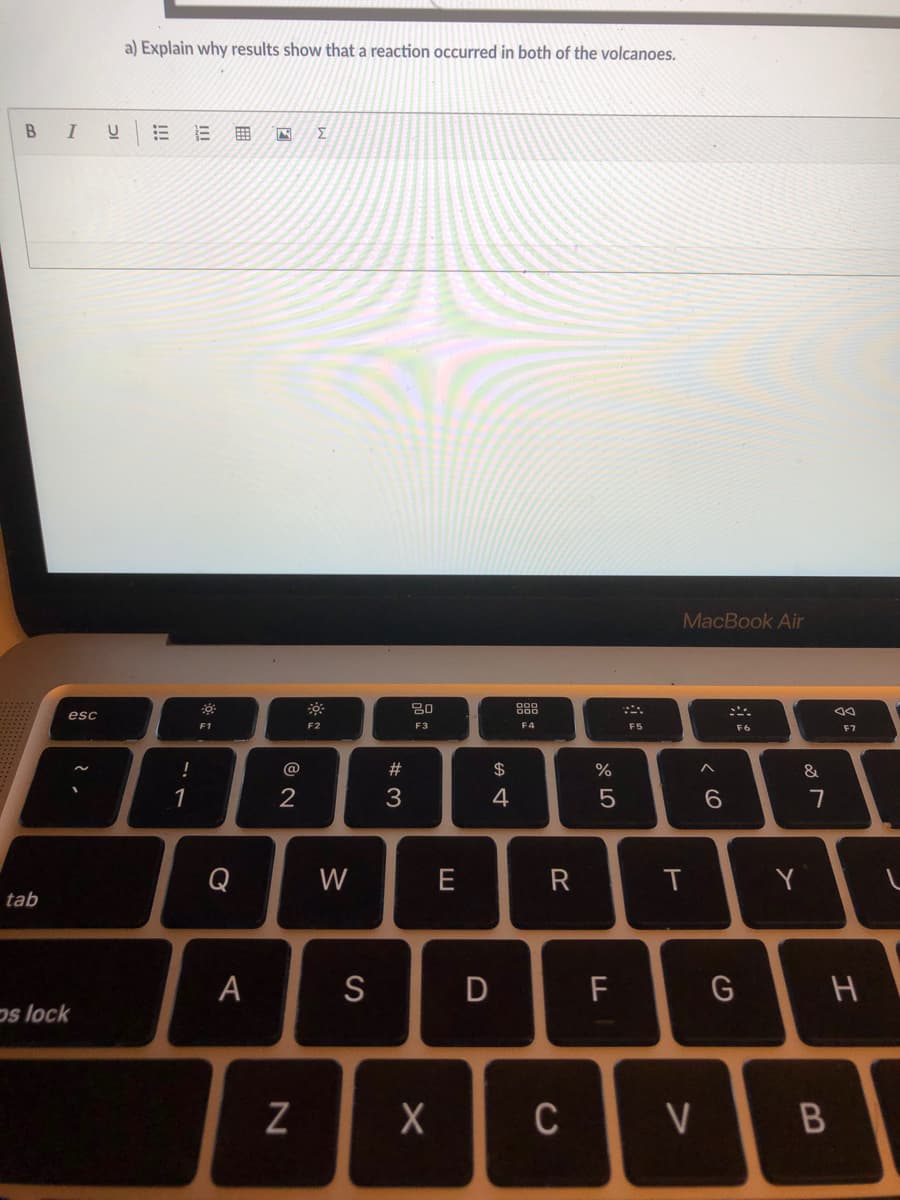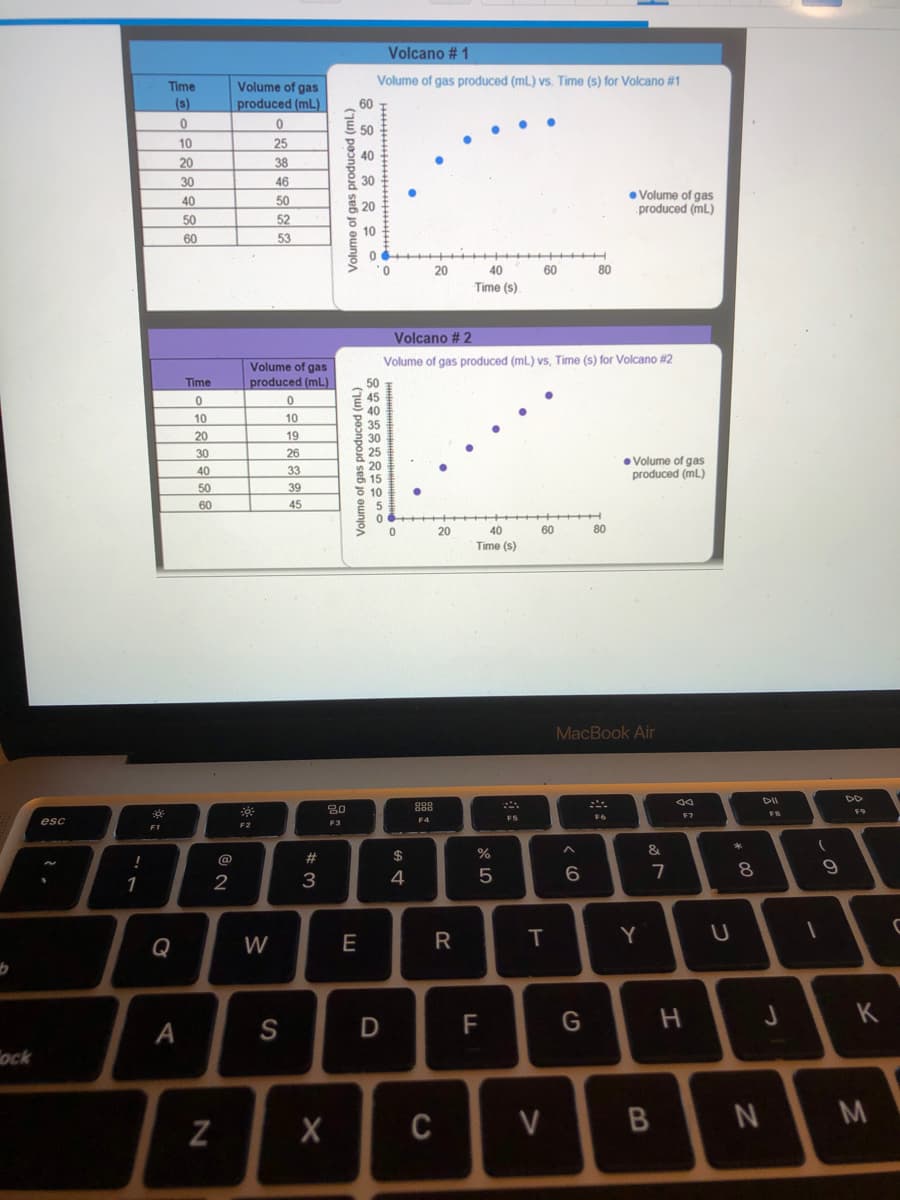Introductory Chemistry: An Active Learning Approach
6th Edition
ISBN:9781305079250
Author:Mark S. Cracolice, Ed Peters
Publisher:Mark S. Cracolice, Ed Peters
Chapter2: Matter And Energy
Section: Chapter Questions
Problem 7E: 7.The word pour is commonly used in reference to liquids but not to solids or gases. Can you pour a...
Related questions
Question

Transcribed Image Text:a) Explain why results show that a reaction occurred in both of the volcanoes.
MacBook Air
80
888
esc
F1
F2
F3
F4
F5
F6
F7
@
23
$
&
1
2
3
4
Q
W
E
R
Y
tab
A
S
F
G
os lock
V
B
CI

Transcribed Image Text:Volcano # 1
Volume of gas produced (ml) vs. Time (s) for Volcano #1
Volume of gas
produced (mL)
Time
(s)
60
50
10
25
40
20
38
30
46
9 30
• Volume of gas
produced (mL)
40
50
20
50
52
10
60
53
0.
20
40
60
80
Time (s)
Volcano # 2
Volume of gas produced (ml) vs, Time (s) for Volcano #2
Volume of gas
Time
produced (mL)
50
45
40
10
10
20
19
30
25
30
26
• Volume of gas
produced (mL)
40
33
50
39
60
45
20
40
60
80
Time (s)
MacBook Air
DD
80
888
F9
F6
F7
esc
F3
F4
FS
F1
F2
@
23
$
7
8.
1
2
3
4
Q
W
E
R
T
Y
K
A
S
F
ock
C
V
Volume of gas produced (mL.)
(ju) peɔnpoud seß jo ewnjo
Expert Solution
This question has been solved!
Explore an expertly crafted, step-by-step solution for a thorough understanding of key concepts.
This is a popular solution!
Trending now
This is a popular solution!
Step by step
Solved in 2 steps with 3 images

Knowledge Booster
Learn more about
Need a deep-dive on the concept behind this application? Look no further. Learn more about this topic, chemistry and related others by exploring similar questions and additional content below.Recommended textbooks for you

Introductory Chemistry: An Active Learning Approa…
Chemistry
ISBN:
9781305079250
Author:
Mark S. Cracolice, Ed Peters
Publisher:
Cengage Learning

General Chemistry - Standalone book (MindTap Cour…
Chemistry
ISBN:
9781305580343
Author:
Steven D. Gammon, Ebbing, Darrell Ebbing, Steven D., Darrell; Gammon, Darrell Ebbing; Steven D. Gammon, Darrell D.; Gammon, Ebbing; Steven D. Gammon; Darrell
Publisher:
Cengage Learning

Chemistry for Engineering Students
Chemistry
ISBN:
9781337398909
Author:
Lawrence S. Brown, Tom Holme
Publisher:
Cengage Learning

Introductory Chemistry: An Active Learning Approa…
Chemistry
ISBN:
9781305079250
Author:
Mark S. Cracolice, Ed Peters
Publisher:
Cengage Learning

General Chemistry - Standalone book (MindTap Cour…
Chemistry
ISBN:
9781305580343
Author:
Steven D. Gammon, Ebbing, Darrell Ebbing, Steven D., Darrell; Gammon, Darrell Ebbing; Steven D. Gammon, Darrell D.; Gammon, Ebbing; Steven D. Gammon; Darrell
Publisher:
Cengage Learning

Chemistry for Engineering Students
Chemistry
ISBN:
9781337398909
Author:
Lawrence S. Brown, Tom Holme
Publisher:
Cengage Learning

Introductory Chemistry: A Foundation
Chemistry
ISBN:
9781337399425
Author:
Steven S. Zumdahl, Donald J. DeCoste
Publisher:
Cengage Learning


World of Chemistry, 3rd edition
Chemistry
ISBN:
9781133109655
Author:
Steven S. Zumdahl, Susan L. Zumdahl, Donald J. DeCoste
Publisher:
Brooks / Cole / Cengage Learning